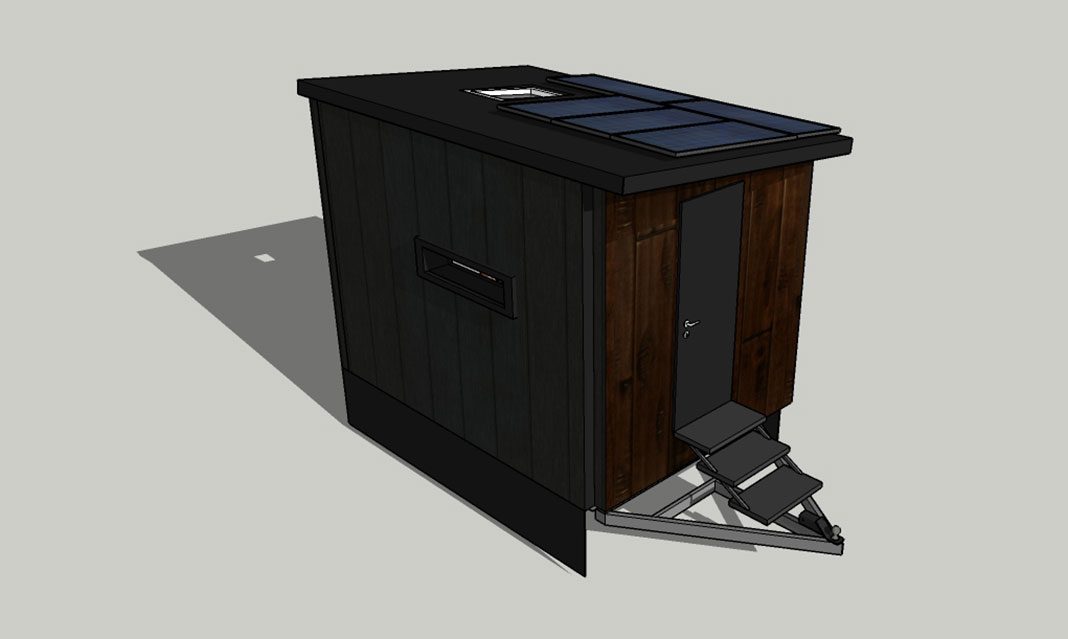The tiny house movement, a name coined in contrast to the current “normal-sized” house, is the architectural and social movement that advocates living minimally in small homes. While family size decreased, the average North American house grew to 2500 square feet. A living space under 500 square feet is referred to as a tiny house.
While most university students are just now learning the importance of being financially responsible, Kieran, a second-year student at UTM, and Meghan, an industrial design student at OCAD, have saved up and invested over the years to become the proud owners of a tiny house by mid-October.
“I found out about it five years ago, been researching it for two years [but] I’ve been convincing [Meghan] for the last three years so it has been a long project,” Kieran laughs.
Kieran and Meghan put up advertisements on Facebook, GumTree, Kijiji, and the basement of the Davis building where we learned of their tiny house. The ad asked if anyone would allow them to “live” or park on their land.
The Medium sat down with Kieran to learn more about the whole process; more importantly, why were they choosing to do this? “Self-sustainability,” he stated. Avoiding the rent trap was his driving force amongst others. While most university students have OSAP to pay off and mortgages to take on, Kieran and his partner plan to live a relatively debt-free life for the next three to four years that he plans on being in Toronto.
Kieran explains that not only was this a fiscally freeing decision, but there is an environmental factor at play too. Kieran and Meghan describe how they both lead relatively minimal and eco-conscious lifestyles: buying from bulk barn, using reusable containers, and generally being waste-free. “Being completely off-grid, that has a lot of benefits. Most of our power in Canada is generated from coal and oil, only a tiny percentage is renewable so [this way] we can be completely renewable, pretty cheap,” says Meghan.
A tiny house also gives you the freedom to go wherever you want without the financial pressures of hotels and flights, Kieran explains. It’s like an RV, but one which you live in full-time.
Commenting on how their tiny house is in fact less than 100 square feet, Kieran explained how they have only seen two other people in the world who have constructed houses that small. It’s been six months since they started, “the whole house is completely custom, so you have to understand every aspect of it—from the trailer, to the insulation, to being off-grid. So you need solar panels and a composting toilet. You have to talk zoning and where you want to live, and maybe talk to the councils so there is a lot involved.”
Kieran discusses how the first contractor they were with had preset designs, and they ended up going to another contractor because they downsized even further and wanted it to be extremely customized, which involved having to know everything they wanted beforehand. This included drawing sketches and creating a walkthrough design that represented what they wanted their tiny house to look like. “All the paper work, blueprints, and floorplans takes two weeks. And after that, for them to actually build it, it takes four to six weeks.” They still have four to six weeks until they sign off on the final design.
FENIX NTM, a material that has only been used for counters and walls was used for the entirety of Kieran’s tiny home. It was used for the cabinetry, the shower and possibly the ceiling. “If you cut into it or heat it up, the particles will realign and it will heal itself. Basically, can’t damage it. It’s waterproof, fingerprint resistant, heatproof, all the proofs,” Kieran exclaimed.
A tiny house can cost from $20,000 to $60,000. The cost for Kieran and Meghan’s tiny house is projected to be toward the lower end of the spectrum.
“We’re considering it a tiny home, but about a hundred years ago, these were just normal sizes.”
Kieran and Meghan have received about a hundred emails just expressing support, and forty people willing to give them a place to park their tiny house.
In the context of the recent debate on whether the tiny house movement can be a solution for homelessness, and the problems faced when looking for affordable housing, Kieran says that, “counties in the US are implementing tiny homes for the homeless. […] It costs some cities 10 to 50 grand a year just on average to deal with the homeless, whereas they could house these people for a fraction of the cost and that would be including water, power, and light.”
However, it isn’t all black and white. According to the website, homelesshub.ca, tiny houses are not a complete solution to the problem. “Many criticisms of tiny houses relate to the fact that they could be considered cramped, cold, and a health and safety risk to residents. In a Canadian context, tiny houses would need to be heavily insulated, well heated, and dry throughout the winter. The Dragonfly, a 160 square foot tiny house by Robinson Residential Design in Regina, was designed with this consideration in mind and can withstand winter temperatures as cold as minus 40 Celsius. “At $75,000, the Dragonfly appears to be more affordable than most houses on the market, but still expensive for low-income or unemployed individuals,” the article reads.
Conversations then shift to whether housing is treated as a commodity or as a necessity. According to Leilani Farha in her United Nations report, “Homelessness occurs when housing is treated as a commodity rather than as a human right.”
The Medium is hoping to follow up with Kieran and Meghan by mid-October when their house is ready.




Build your own tiny house. http://www.tinyhomebueprints.com I think a tiny house is all me and my dog would need. of course i’d have to get rid of a lot of junk. Where would it fit?